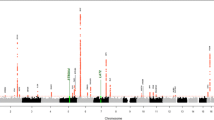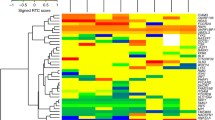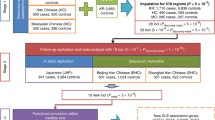Abstract
Previous studies have observed relationships between immune cells and systemic lupus erythematosus (SLE), but their causal links remain undetermined. Based on the public available genome-wide association studies (GWAS) summary statistics, we conducted two-sample Mendelian randomization (MR) to evaluate the associations between 731 immune phenotypes and SLE pairs. Pairwise pleiotropy analysis was performed to identify pleiotropic genes for significant immunophenotype–SLE pairs. A comprehensive gene function analysis was undertaken to explore the mechanisms of immune cells in SLE. By using the instrumental variables extracted from GWAS data, we observed that increased levels of five immune phenotypes were causally associated with SLE risk (FDR < 0.05), that were CD20 on IgD+ CD38− naïve, BAFF-R on IgD+ CD38dim, CD39+ secreting Treg AC, CD14− CD16+ monocyte AC, and HLA DR on CD14+ monocyte. Pairwise gene-based analyses identified a total of 38 pleiotropic genes for 5 significant pairs identified and gene set enrichment analysis revealed the involvement of the identified pleiotropic genes in complex pathways (i.e., systemic lupus erythematosus, an integral component of luminal side of endoplasmic reticulum membrane, C-type lectin receptor signaling pathway and regulation of hormone secretion). This study demonstrates that the immune response influences the progression of SLE in a complex pattern. These findings greatly improve our understanding of the interaction between immune response and SLE risk and also aid in the design of therapeutic strategies from an immunological perspective.






Similar content being viewed by others
Data availability
Data are available in a public, open access repository. Data URLs: GWAS summary statistics for 731 immune traits could be download form GWAS Catalog (Study accession: GCST90001001 ~ GCST90002000, https://www.ebi.ac.uk/gwas/home); GWAS summary statistics for SLE could be available form http://mygeneticswebsite.s3-website.eu-west-2.amazonaws.com/insidegen-LUPUS-data.html. All codes used in the research are available from the corresponding authors.
References
Abecasis GR, Auton A, Brooks LD, DePristo MA, Durbin RM, Handsaker RE et al (2012) An integrated map of genetic variation from 1,092 human genomes. Nature 491(7422):56–65
Álvarez-Sánchez N, Cruz-Chamorro I, Díaz-Sánchez M, Lardone PJ, Guerrero JM, Carrillo-Vico A (2019) Peripheral CD39-expressing T regulatory cells are increased and associated with relapsing-remitting multiple sclerosis in relapsing patients. Sci Rep 9(1):2302
Bentham J, Morris DL, Graham DSC, Pinder CL, Tombleson P, Behrens TW et al (2015) Genetic association analyses implicate aberrant regulation of innate and adaptive immunity genes in the pathogenesis of systemic lupus erythematosus. Nat Genet 47(12):1457–1464
Biesen R, Demir C, Barkhudarova F, Grün JR, Steinbrich-Zöllner M, Backhaus M et al (2008) Sialic acid-binding Ig-like lectin 1 expression in inflammatory and resident monocytes is a potential biomarker for monitoring disease activity and success of therapy in systemic lupus erythematosus. Arthritis Rheum 58(4):1136–1145
Bowden J, Smith GD, Haycock PC, Burgess S (2016) Consistent estimation in Mendelian randomization with some invalid instruments using a weighted median estimator. Genet Epidemiol 40(4):304–314
Burgess S, Thompson SG (2015) Multivariable mendelian randomization: the use of pleiotropic genetic variants to estimate causal effects. Am J Epidemiol 181(4):251–260
Burgess S, Thompson SG (2017) Interpreting findings from Mendelian randomization using the MR-Egger method. Eur J Epidemiol 32(5):377–389
Burgess S, Small DS, Thompson SG (2017) A review of instrumental variable estimators for Mendelian randomization. Stat Methods Med Res 26(5):2333–2355
Cao RR, Yu XH, Xiong MF, Li XT, Deng FY, Lei SF (2022) The immune factors have complex causal regulation effects on bone mineral density. Front Immunol 13:959417
Carter RH, Zhao H, Liu X, Pelletier M, Chatham W, Kimberly R et al (2005) Expression and occupancy of BAFF-R on B cells in systemic lupus erythematosus. Arthritis Rheum 52(12):3943–3954
Chambers J (2008) Software for data analysis: programming with R. Springer Science & Business Media
Clark RA (2015) Resident memory T cells in human health and disease. Sci Transl Med 7(269):269rv1
Cook RD (1977) Detection of influential observation in linear regression. Technometrics 19(1):15–18
Costanza M, Binart N, Steinman L, Pedotti R (2015) Prolactin: a versatile regulator of inflammation and autoimmune pathology. Autoimmun Rev 14(3):223–230
Cros J, Cagnard N, Woollard K, Patey N, Zhang SY, Senechal B et al (2010) Human CD14dim monocytes patrol and sense nucleic acids and viruses via TLR7 and TLR8 receptors. Immunity 33(3):375–386
Cunningham MA, Wirth JR, Freeman LR, Boger HA, Granholm AC, Gilkeson GS (2014) Estrogen receptor alpha deficiency protects against development of cognitive impairment in murine lupus. J Neuroinflamm 11:171
de Leeuw CA, Mooij JM, Heskes T, Posthuma D (2015) MAGMA: generalized gene-set analysis of GWAS data. PLoS Comput Biol 11(4):e1004219
Didier K, Bolko L, Giusti D, Toquet S, Robbins A, Antonicelli F et al (2018) Autoantibodies associated with connective tissue diseases: what meaning for clinicians? Front Immunol 9:541
Duan JH, Jiang Y, Mu H, Tang ZQ (2016) Expression of BAFF and BR3 in patients with systemic lupus erythematosus. Braz J Med Biol Res 49(3):e4853
Durcan L, O’Dwyer T, Petri M (2019) Management strategies and future directions for systemic lupus erythematosus in adults. Lancet 393(10188):2332–2343
Emdin CA, Khera AV, Kathiresan S (2017) Mendelian randomization. JAMA 318(19):1925–1926
Geijtenbeek TB, Gringhuis SI (2009) Signalling through C-type lectin receptors: shaping immune responses. Nat Rev Immunol 9(7):465–479
Genomes Project C, Auton A, Brooks LD, Durbin RM, Garrison EP, Kang HM et al (2015) A global reference for human genetic variation. Nature 526(7571):68–74
Hartwig FP, Davey Smith G, Bowden J (2017) Robust inference in summary data Mendelian randomization via the zero modal pleiotropy assumption. Int J Epidemiol 46(6):1985–1998
Hirose S, Lin Q, Ohtsuji M, Nishimura H, Verbeek JS (2019) Monocyte subsets involved in the development of systemic lupus erythematosus and rheumatoid arthritis. Int Immunol 31(11):687–696
Huang H, Xu R, Lin F, Bao C, Wang S, Ji C et al (2015) High circulating CD39(+) regulatory T cells predict poor survival for sepsis patients. Int J Infect Dise 30:57–63
Jacobson JD, Ansari MA, Kinealy M, Muthukrishnan V (1999) Gender-specific exacerbation of murine lupus by gonadotropin-releasing hormone: potential role of G alpha(q/11). Endocrinology 140(8):3429–3437
Karrar S, Cunninghame Graham DS (2018) Abnormal B cell development in systemic lupus erythematosus: what the genetics tell us. Arthritis Rheumatol (hoboken, NJ) 70(4):496–507
Kiriakidou M, Ching CL (2020) Systemic lupus erythematosus. Ann Intern Med 172(11):Itc81–Itc96
Li D, Lu L, Kong W, Xia X, Pan Y, Li J et al (2021) C-type lectin receptor Dectin3 deficiency balances the accumulation and function of FoxO1-mediated LOX-1(+) M-MDSCs in relieving lupus-like symptoms. Cell Death Dis 12(9):829
McGowan LM, Davey Smith G, Gaunt TR, Richardson TG (2019) Integrating Mendelian randomization and multiple-trait colocalization to uncover cell-specific inflammatory drivers of autoimmune and atopic disease. Hum Mol Genet 28(19):3293–3300
Mukherjee R, Kanti Barman P, Kumar Thatoi P, Tripathy R, Kumar Das B, Ravindran B (2015) Non-classical monocytes display inflammatory features: validation in sepsis and systemic lupus erythematous. Sci Rep 5:13886
Nashi E, Wang Y, Diamond B (2010) The role of B cells in lupus pathogenesis. Int J Biochem Cell Biol 42(4):543–550
Orrù V, Steri M, Sidore C, Marongiu M, Serra V, Olla S et al (2020) Complex genetic signatures in immune cells underlie autoimmunity and inform therapy. Nat Genet 52(10):1036 1045
Pan L, Lu MP, Wang JH, Xu M, Yang SR (2020) Immunological pathogenesis and treatment of systemic lupus erythematosus. World J Pediatr WJP 16(1):19–30
Pavlasova G, Mraz M (2020) The regulation and function of CD20: an “enigma” of B-cell biology and targeted therapy. Haematologica 105(6):1494–1506
Purcell S, Neale B, Todd-Brown K, Thomas L, Ferreira MA, Bender D et al (2007) PLINK: a tool set for whole-genome association and population-based linkage analyses. Am J Human Genet 81(3):559–575
Rees JMB, Wood AM, Dudbridge F, Burgess S (2019) Robust methods in Mendelian randomization via penalization of heterogeneous causal estimates. PLoS ONE 14(9):e0222362
Sakaue S, Kanai M, Tanigawa Y, Karjalainen J, Kurki M, Koshiba S et al (2021) A cross-population atlas of genetic associations for 220 human phenotypes. Nat Genet 53(10):1415–1424
Salazar-Camarena DC, Ortíz-Lazareno P, Marín-Rosales M, Cruz A, Muñoz-Valle F, Tapia-Llanos R et al (2019) BAFF-R and TACI expression on CD3+ T cells: interplay among BAFF, APRIL and T helper cytokines profile in systemic lupus erythematosus. Cytokine 114:115–127
Shah S, Henry A, Roselli C, Lin H, Sveinbjörnsson G, Fatemifar G et al (2020) Genome-wide association and Mendelian randomisation analysis provide insights into the pathogenesis of heart failure. Nat Commun 11(1):163
Sidore C, Busonero F, Maschio A, Porcu E, Naitza S, Zoledziewska M et al (2015) Genome sequencing elucidates Sardinian genetic architecture and augments association analyses for lipid and blood inflammatory markers. Nat Genet 47(11):1272–1281
Smulski CR, Eibel H (2018) BAFF and BAFF-receptor in B cell selection and survival. Front Immunol 9:2285
Sompayrac LM (2019) How the immune system works. Wiley
Steri M, Orrù V, Idda ML, Pitzalis M, Pala M, Zara I et al (2017) Overexpression of the cytokine BAFF and autoimmunity risk. N Engl J Med 376(17):1615–1626
Tsokos GC (2011) Systemic lupus erythematosus. N Engl J Med 365(22):2110–2121
Tsur A, Hughes GC, Shoenfeld Y, Carp H (2015) Interdisciplinary exchange of ideas: progestagens for autoimmunity, biologics for pregnancy complications. Immunol Res 61(1–2):31–34
Verbanck M, Chen C-Y, Neale B, Do R (2018) Detection of widespread horizontal pleiotropy in causal relationships inferred from Mendelian randomization between complex traits and diseases. Nat Genet 50(5):693
Vincent FB, Saulep-Easton D, Figgett WA, Fairfax KA, Mackay F (2013) The BAFF/APRIL system: emerging functions beyond B cell biology and autoimmunity. Cytokine Growth Factor Rev 24(3):203–215
Watanabe K, Taskesen E, van Bochoven A, Posthuma D (2017) Functional mapping and annotation of genetic associations with FUMA. Nat Commun 8(1):1826
Yang J, Yan B, Zhao B, Fan Y, He X, Yang L et al (2020) Assessing the causal effects of human serum metabolites on 5 major psychiatric disorders. Schizophr Bull 46(4):804–813
Yavorska OO, Burgess S (2017) MendelianRandomization: an R package for performing Mendelian randomization analyses using summarized data. Int J Epidemiol 46(6):1734–1739
Ye T, Shao J, Kang H (2021) Debiased inverse-variance weighted estimator in two-sample summary-data Mendelian randomization. Ann Stat 49(4):2079–2100 (22)
Yu X, Wang T, Huang S, Zeng P (2020) Evaluation of the causal effects of blood lipid levels on gout with summary level GWAS data: two-sample Mendelian randomization and mediation analysis. J Hum Genet 66(5):465-473
Yu XH, Yang YQ, Cao RR, Cai MK, Zhang L, Deng FY et al (2021a) Rheumatoid arthritis and osteoporosis: shared genetic effect, pleiotropy and causality. Hum Mol Genet 30(21):1932–1940
Yu XH, Yang YQ, Cao RR, Bo L, Lei SF (2021b) The causal role of gut microbiota in development of osteoarthritis. Osteoarthr Cartil 29(12):1741–1750
Yu XH, Cao RR, Yang YQ, Lei SF (2022) Identification of causal metabolites related to multiple autoimmune diseases. Hum Mol Genet 31(4):604–613
Zhao Q, Wang J, Hemani G, Bowden J, Small DS (2020) Statistical inference in two-sample summary-data Mendelian randomization using robust adjusted profile score. Ann Stat 48(3):1742–1769 (28)
Zhou Y, Zhou B, Pache L, Chang M, Khodabakhshi AH, Tanaseichuk O et al (2019) Metascape provides a biologist-oriented resource for the analysis of systems-level datasets. Nat Commun 10(1):1523
Zhu H, Hu F, Sun X, Zhang X, Zhu L, Liu X et al (2016) CD16(+) monocyte subset was enriched and functionally exacerbated in driving T-cell activation and B-cell response in systemic lupus erythematosus. Front Immunol 7:512
Acknowledgements
We thank all the consortiums for making the summary association statistics data publicly available, and we are grateful to the participants and many researchers involved in proteome GWAS studies.
Funding
This work was supported by National Natural Science Foundation of China (82273733) to Lihong Huang.
Author information
Authors and Affiliations
Contributions
HL, and JG conceived the design of the study; HL, YZ and JG obtained the data; HL and GY cleared up the datasets; HL, XK, LH and GY mainly performed the data analyses; HL, GY, JG and LH drafted and revised the manuscript, and all authors approved the manuscript and provided relevant suggestions.
Corresponding authors
Ethics declarations
Conflict of interest
Guan-min Yan, Jie Gu, Xiao-Lin Kong, Yin-Ying Zhang, Li-Hong Huang, Hui-Min Lu declare that they have no conflicts of interest.
Web resources
MAGMA, https://ctg.cncr.nl/software/magma; FUMA, https://fuma.ctglab.nl; Metascape, https://metascape.org; PLINK, https://www.cog-genomics.org; R, https://www.r-project.org.
Additional information
Communicated by Shuhua Xu.
Publisher's Note
Springer Nature remains neutral with regard to jurisdictional claims in published maps and institutional affiliations.
Supplementary Information
Below is the link to the electronic supplementary material.
438_2023_2071_MOESM1_ESM.xlsx
Table S1. Instrusmental variables for five identified immune cells. Table S2. Sensitive analysis for causal associations of all immune cells on SLE risk. Table S3. MR-PRESSO analysis for effects of identified immune cells on SLE risk. Table S4. Causal associations of all immune cells on SLE risk after removing IVs associated with other immune cells. Table S5. Identified pleiotropic genes
Rights and permissions
Springer Nature or its licensor (e.g. a society or other partner) holds exclusive rights to this article under a publishing agreement with the author(s) or other rightsholder(s); author self-archiving of the accepted manuscript version of this article is solely governed by the terms of such publishing agreement and applicable law.
About this article
Cite this article
Gu, J., Yan, GM., Kong, XL. et al. Assessing the causal relationship between immune traits and systemic lupus erythematosus by bi-directional Mendelian randomization analysis. Mol Genet Genomics 298, 1493–1503 (2023). https://doi.org/10.1007/s00438-023-02071-9
Received:
Accepted:
Published:
Issue Date:
DOI: https://doi.org/10.1007/s00438-023-02071-9




